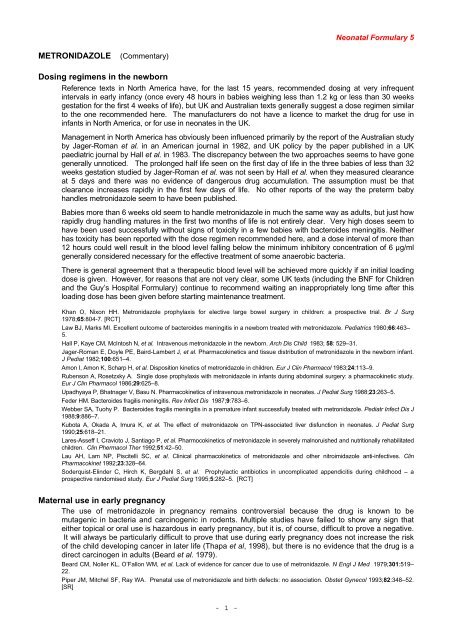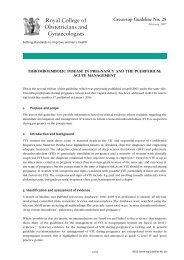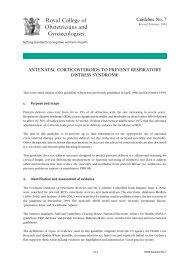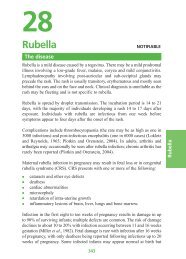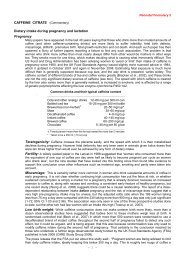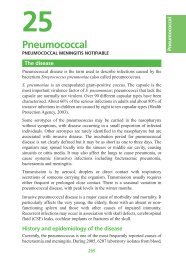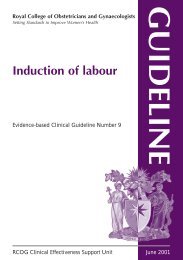METRONIDAZOLE (Commentary) - Neonatal Formulary
METRONIDAZOLE (Commentary) - Neonatal Formulary
METRONIDAZOLE (Commentary) - Neonatal Formulary
Create successful ePaper yourself
Turn your PDF publications into a flip-book with our unique Google optimized e-Paper software.
<strong>Neonatal</strong> <strong>Formulary</strong> 5<br />
<strong>METRONIDAZOLE</strong> (<strong>Commentary</strong>)<br />
Dosing regimens in the newborn<br />
Reference texts in North America have, for the last 15 years, recommended dosing at very infrequent<br />
intervals in early infancy (once every 48 hours in babies weighing less than 1.2 kg or less than 30 weeks<br />
gestation for the first 4 weeks of life), but UK and Australian texts generally suggest a dose regimen similar<br />
to the one recommended here. The manufacturers do not have a licence to market the drug for use in<br />
infants in North America, or for use in neonates in the UK.<br />
Management in North America has obviously been influenced primarily by the report of the Australian study<br />
by Jager-Roman et al. in an American journal in 1982, and UK policy by the paper published in a UK<br />
paediatric journal by Hall et al. in 1983. The discrepancy between the two approaches seems to have gone<br />
generally unnoticed. The prolonged half life seen on the first day of life in the three babies of less than 32<br />
weeks gestation studied by Jager-Roman et al. was not seen by Hall et al. when they measured clearance<br />
at 5 days and there was no evidence of dangerous drug accumulation. The assumption must be that<br />
clearance increases rapidly in the first few days of life. No other reports of the way the preterm baby<br />
handles metronidazole seem to have been published.<br />
Babies more than 6 weeks old seem to handle metronidazole in much the same way as adults, but just how<br />
rapidly drug handling matures in the first two months of life is not entirely clear. Very high doses seem to<br />
have been used successfully without signs of toxicity in a few babies with bacteroides meningitis. Neither<br />
has toxicity has been reported with the dose regimen recommended here, and a dose interval of more than<br />
12 hours could well result in the blood level falling below the minimum inhibitory concentration of 6 µg/ml<br />
generally considered necessary for the effective treatment of some anaerobic bacteria.<br />
There is general agreement that a therapeutic blood level will be achieved more quickly if an initial loading<br />
dose is given. However, for reasons that are not very clear, some UK texts (including the BNF for Children<br />
and the Guy’s Hospital <strong>Formulary</strong>) continue to recommend waiting an inappropriately long time after this<br />
loading dose has been given before starting maintenance treatment.<br />
Khan O, Nixon HH. Metronidazole prophylaxis for elective large bowel surgery in children: a prospective trial. Br J Surg<br />
1978;65:804-7. [RCT]<br />
Law BJ, Marks MI. Excellent outcome of bacteroides meningitis in a newborn treated with metronidazole. Pediatrics 1980;66:463–<br />
5.<br />
Hall P, Kaye CM, McIntosh N, et al. Intravenous metronidazole in the newborn. Arch Dis Child 1983; 58: 529–31.<br />
Jager-Roman E, Doyle PE, Baird-Lambert J, et al. Pharmacokinetics and tissue distribution of metronidazole in the newborn infant.<br />
J Pediat 1982;100:651–4.<br />
Amon I, Amon K, Scharp H, et al. Disposition kinetics of metronidazole in children. Eur J Clin Pharmacol 1983;24:113–9.<br />
Rubenson A, Rosetzxky A. Single dose prophylaxis with metronidazole in infants during abdominal surgery: a pharmacokinetic study.<br />
Eur J Clin Pharmacol 1986;29:625–8.<br />
Upadhyaya P, Bhatnager V, Basu N. Pharmacokinetics of intravenous metronidazole in neonates. J Pediat Surg 1988;23:263–5.<br />
Feder HM. Bacteroides fragilis meningitis. Rev Infect Dis 1987;9:783–6.<br />
Webber SA, Tuohy P. Bacteroides fragilis meningitis in a premature infant successfully treated with metronidazole. Pediatr Infect Dis J<br />
1988;9:886–7.<br />
Kubota A, Okada A, Imura K, et al. The effect of metronidazole on TPN-associated liver disfunction in neonates. J Pediat Surg<br />
1990;25:618–21.<br />
Lares-Asseff I, Cravioto J, Santiago P, et al. Pharmocokinetics of metronidazole in severely malnoruished and nutritionally rehabilitated<br />
children. Clin Phermacol Ther 1992;51:42–50.<br />
Lau AH, Lam NP, Piscitelli SC, et al. Clinical pharmacokinetics of metronidazole and other nitroimidazole anti-infectives. Clin<br />
Pharmacokinet 1992;23:328–64.<br />
Soderquist-Elinder C, Hirch K, Bergdahl S, et al. Prophylactic antibiotics in uncomplicated appendicitis during childhood – a<br />
prospective randomised study. Eur J Pediat Surg 1995;5:282–5. [RCT]<br />
Maternal use in early pregnancy<br />
The use of metronidazole in pregnancy remains controversial because the drug is known to be<br />
mutagenic in bacteria and carcinogenic in rodents. Multiple studies have failed to show any sign that<br />
either topical or oral use is hazardous in early pregnancy, but it is, of course, difficult to prove a negative.<br />
It will always be particularly difficult to prove that use during early pregnancy does not increase the risk<br />
of the child developing cancer in later life (Thapa et al, 1998), but there is no evidence that the drug is a<br />
direct carcinogen in adults (Beard et al. 1979).<br />
Beard CM, Noller KL, O’Fallon WM, et al. Lack of evidence for cancer due to use of metronidazole. N Engl J Med 1979;301:519–<br />
22.<br />
Piper JM, Mitchel SF, Ray WA. Prenatal use of metronidazole and birth defects: no association. Obstet Gynecol 1993;82:348–52.<br />
[SR]<br />
- 1 -
<strong>Neonatal</strong> <strong>Formulary</strong> 5<br />
Burtin P, Taddio A, Ariburna O, et al. Safety of metronidazole in pregnancy : a meta-analysis. Am J Obstet Gynecol 1995; 172: 525–9.<br />
[SR]<br />
Caro-Paton P, Taddio A, Ariburnu O, et al. Is metronidazole teratogenic ? A meta-analysis. Br J Clin Pharmacol 1997;44:179–92.<br />
[SR]<br />
Czeizel AE, Rockenbauer M. A population based case-control teratologic study of oral metronidazole treatment during pregnancy.<br />
Br J Obset Gynaecol 1998;105:322–9.<br />
Thapa PB, Whitlock JA, Brockman Worrell KG, et al. Prenatal exposure to metronidazole and risk of childhood cancer. A<br />
retrospective cohort study of children younger than 5 years. Cancer 1998;83:1461–8.<br />
Sorensen HT, Larsen H, Thulstrup AM, et al. Safety of metronidazole during pregnancy: a cohort study of risk of congenital<br />
abnormalities, preterm delivery and low birth weight in 124 women. J Antimicrob Chemother 1999;44:854–5.<br />
Therapeutic use later in pregnancy<br />
Treatment will nearly always clear vaginal infection, but there is no evidence as yet that this reduces the<br />
risk of preterm birth. Where infection is due to Chlamydia trachomatis both partners should be treated if<br />
possible.<br />
Hauth JC, Golenberg RL, Andrews WW, et al. Reduced incidence of preterm delivery with metronidazole and erythromycin in women<br />
with bacterial vaginosis. N Engl J Med 1995;333:1732–6. [RCT]<br />
Svare J, Langhoff-Roos J, Andersoen LF, et al. Ampicillin-metronidaxole treatment in idiopathic preterm labour: a randomised<br />
controlled multicentre trial. Br J Obstet Gynaecol 1997;104:892–9 [RCT]<br />
McDonald HM, O’Loughlin JA, Vigeswaran R, et al. Impact of metronidazole therapy on preterm birth in women with bacterial vaginosis<br />
flora (Gardnerella vaginilis): a randomized placebo-controlled trial. Br J Obstet Gynaecol 1997;104:1391–7. [RCT]<br />
Carey JC, and the National Institute of Child Health and Human Development Network of Maternal-Fetal Medicine Units. Metronidazole<br />
to prevent preterm delivery in pregnant women with asymptomatic bacterial vaginosis. N Engl J Med 2000;342:534–40. [RCT]<br />
Klebanoff MA, Carey JC, Hauth JC, et al. Failure of metronidazole to prevent preterm delivery among pregnant women with<br />
asymptomatic trichomonas vaginalis infection. N Eng J Med 2001;345:487–93. [RCT]<br />
Shennan A, Crawshaw S, Briley A, et al. A randomised controlled trial of metronidazole for the prevention of preterm birth in<br />
women positive for cervicovaginal fetal fibronectin: the PREMET trial. BJOG 2006;113:65–74. [RCT]<br />
Metronidazole and lactation<br />
Apart from one early anecdotal report of diarrhoea in a breast fed baby whose mother was given<br />
metronidazole (Clements, 1980), maternal treatment during lactation seems to have been uneventful.<br />
There seems to be a sustained reluctance to endorse the systemic use of metronidazole in mothers who<br />
are breast feeding in North America. This arose because in vitro studies generated theoretical concerns<br />
about the drug’s carcinogenic and mutagenic potential. While the relevant FDA warnings have never<br />
been withdrawn, the legitimacy of any such extrapolation can be questioned, and widespread use has<br />
not yet brought any clinical problem to light.<br />
Clements CJ. Metronidazole and breast feeding. NZ Med J 1980;92:329.<br />
Erilkson SH, Oppenheim GL, Smith GH. Metronidazole and breast milk. Obstet Gynecol 1981;57:48–50.<br />
Heisterberg L, Branebjerg PE. Blood and milk concentrations of metronidazole in mothers and infants.J Perinat Med 1983;11:114–20.<br />
Passmore CM, McElnay JC, Rainey EA, et al. Metronidazole excretion in human milk and its effect on the suckling neonate. Br J<br />
Clin Pharmacol 1988;26:45–51.<br />
Chung AM, Reed MD, Blumer JL. Antibiotics and breast-feeding. A critical review of the literature. Pediatr Drugs 2002;4:817–37.<br />
Management of necrotising enterocolitis<br />
Mortality in this poorly understood condition still exceeds 20% despite antibiotic treatment once intestinal<br />
perforation has occurred. Prophylactic measures and preventive strategies have received remarkably<br />
little study given the frequency with which this problem is now encountered in the very preterm baby.<br />
Observational studies suggest that breast milk can be protective, and there is one trial using an IgA-rich<br />
immunoglobulin that lends credence to this view. Small trials have suggested that oral prophylaxis with<br />
a poorly absorbed antibiotic can also provide substantial protection. A further large trial linked to an<br />
audit of all other sepsis will, however, be necessary to answer lingering concern that such an approach<br />
could eventually cause a rise in the total number of unit deaths attributable to candida infection, or to<br />
multiply-resistant Gram-negative bacteria. Whether delayed enteral feeding also reduces the risk<br />
remains very unclear.<br />
There is equal uncertainty as to the best surgical strategy to adopt. ‘Staging’ (even using Kliegman’s<br />
modification of the Bell score) is a poor measure of disease severity. It is much more important to know<br />
whether there is focal, multifocal, or pan-intestinal gut involvement, or gangrene of the whole intestinal<br />
tract. An approach involving nothing more than peritoneal drainage until the baby can be stabilised has<br />
become steadily more popular during the last twenty years. It has even been thought that such an<br />
approach can sometimes make later laparotomy unnecessary. However a meta-analysis of the<br />
available observational reports suggests that survival may be not much better than that achieved by<br />
immediate laparotomy and resection with or without a defunctioning enterostomy (or a ‘patch, drain and<br />
- 2 -
<strong>Neonatal</strong> <strong>Formulary</strong> 5<br />
wait’ approach if there seems to be widespread pathology). As a result, two prospective, multicentre,<br />
randomised controlled trials (the NEC and the NECSTEPS trials) were set up to address these<br />
questions in 2003. For more details contact Mr Pierro (a.pierro@ich.ucl.ac.uk).<br />
Metronidazole is widely used where necrotizing enterocolitis is suspected in the UK along with<br />
flucoxacillin and gentamicin, but a combination of ampicillin, gentamicin and clindamycin is the most<br />
widely favoured regimen in North America. Peritoneal swabs should be taken for aerobic and anaerobic<br />
culture wherever possible to guide a less empirical approach to treatment. One recent study (Coates et<br />
al, 2005) suggests that while enterobacteriaceae, with or without Enterococci, are very frequently<br />
isolated in cases of frank necrotizing enterocolitis, coagulase negative staphylococci and Candida<br />
species are the pathogens most frequently isolated in cases of focal intestinal perforation.<br />
Walsh MC, Kleigman RM. Necotizing enterocolitis treatment based on staging criteria. Pediatr Clin North Amer 1986;33:179–201.<br />
Eibl MM, Wolf HM, Fürnkranz H, et al. Prevention of necrotising enterocolitis in low-birth-weight infants by IgA-IgG feeding. N Engl<br />
J Med 1988;319:1–7. [RCT]<br />
Bury RG, Tudehope D. Enteral antibiotics for preventing necrotizing enterocolitis in low birthweight or preterm infants. The<br />
Cochrane Library. Oxford: Update Software, 2000. [SR]<br />
Moss RL, Dimmitt RA, Henry MC, et al. A meta-analysis of peritoneal drainage versus laparotomy for perforated necrotizing<br />
enterocolitis. J Pediatr Surg 2001;36:1201–3.<br />
Pierro A, Hall N. Surgical treatment of infants with necrotizing enterocolitis. Semin Neonat 2003;8:223–32.<br />
Sato TT, Oldham KT. Abdominal drain placement versus laparotomy for necrotizing enterocolitis with perforation. Clin Perinatol<br />
2004;31:577–89.<br />
Coates EW, Karlowsicz MG, Croitoru DP, et al. Distincitve distribution of pathogens aaociated with perintonitis in neonates with<br />
focal intestinal perforation compared with necrotizing enterocolitis. Pediatrics 2005;116:e241–6.<br />
Pierro A. The surgical management of necrotizing enterocolitis. [Review] Early Hum Devel 2005;81:79–85.<br />
<strong>Commentary</strong> posted January 2006<br />
- 3 -


